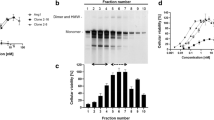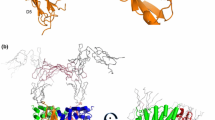Abstract
The Tie2 receptor and its known ligands, the angiopoietins, play a critical role in endothelial cell differentiation during the process of angiogenesis. Recent experimental observations indicate that the agonistic ligand, angiopoietin-1, can stimulate endothelial cell sprouting and act as a chemo-attractant in vitro and induce increased and enhanced angiogenesis both alone and in conjunction with vascular endothelial growth factor (VEGF) in vivo. Here, we present a monoclonal antibody (MAb), which binds to the extracellular portion of the Tie2 receptor and elicits similar agonist effects. Upon MAb binding to the native Tie2 receptor of cultured human umblical vein endothelial cells (HUVEC), there is a rapid increase in receptor autophosphorylation with a concomitant enhancement in the recruitment and association of the signalling intermediates Grb2 and SH-PTP2. The antibody further demonstrates functional activity in vascular tissues. In vitro, the antibody promotes the survival of cultured HUVEC and elicits a dose dependent outgrowth and branching of microvessels from cultured explants of rat aorta. When administered in vivo, the antibody enhances the vascularization of subcutaneous Matrigel implants in mice. Together these data suggest that the antibody is capable of acting as a surrogate ligand for Tie2 and further confirms the role of Tie2 in the differentiation of endothelial cells during angiogenesis.
Similar content being viewed by others
References
Risau W. Mechanisms of angiogenesis. Nature 1997; 386: 671.
Hanahan D. Signalling vascular morphogenesis and maintenance. Science 1997; 277: 48.
Jones PF. Tied up (or down?) with angiopoietins. Angiogenesis 1997; 1: 38.
Davis S, Aldrich TH, Jones PF et al. Isolation of Angiopoietin-1, a ligand for the TIE2 receptor, by secretion-Trap expression cloning. Cell 1996; 87: 1161.
Maisonpierre PC, Suri C, Jones PF et al. Angiopoietin-2, a natural antagonist for Tie2 that disrupts in vivo angiogenesis. Science 1997; 277: 55.
Sato TN, Tozawa Y, Deutsch U et al. Distinct roles of the receptor tyrosine kinases Tie-1 and Tie-2 in blood vessel formation. Nature 1995; 376: 70.
Suri C, Jones PF, Patan S et al. Requisite role of angiopoietin-1, a ligand for the TIE2 receptor, during embryonic angiogenesis. Cell 1996; 87: 1171.
Asahara T, Chen D, Tomono T et al. Tie2 receptor ligands, Angiopoietin-1 and Angiopoietin-2, modulate VEGF-induced postnatal neovascularization. Circ Res 1998; 83: 233.
Suri C, McClain J, Thurston G et al. Increased vascularization in mice overexpressing Angiopoietin-1. Science 1998; 282: 468.
Koblizek TI, Weiss C, Yancopoulos GD et al. Angiopoietin-1 induces sprouting angiogenesis in vitro. Curr Biol 1998; 8: 529.
Witzenbichler B, Maisonpierre PC, Jones P et al. Chemotactic properties of Angiopoietin-1 and-2, ligands for the endothelial-specific receptor tyrosine kinase Tie2. J Biol Chem 1998; 273: 18514.
Takakura N, Huang X, Naruse T et al. Immunity 1998; 9: 677.
Huang L, Turck CW, Rao P, Peters KG. GRB2 and SH-PTP2: potentially important endothelial signalling molecules downstream of the TEK/TIE2 receptor tyrosine kinase. Oncogene 1995; 11:2097.
Kontos CD, Stauffer TP, Yang W et al. Tyrosine 1101 of Tie2 Is the major activation site of association of p85 and Is required for activation of phosphatidylinositol 3-kinase and Akt. Mol Cell Biol 1998; 18: 4131.
Jones N, Dumont DJ. The TEK/Tie2 receptor signals through a novel Dok-related docking protein, Dok-R. Oncogene 1998; 17: 1097.
Clary DO, Weskamp G, Austin LR, Reichardt LF. TrkA Crosslinking mimics neuronal responses to nerve growth factor. Mol Biol Cell 1994; 5: 549.
Schneider H, Chaovapong W, Matthews DJ et al. Homodimerization of erythropoietin receptor by a bivalent monoclonal antibody triggers cell proliferation and differentiation of erythroid precursors. Blood 1997; 89: 473.
Zola H (ed). Monoclonal Antibodies. London, UK, CRC Press Inc., 1987.
Harlow E, Lane D. Antibodies: A Laboratory Manual. Cold Spring Harbor, New York: Cold Spring Harbor Laboratory Press 1988.
Nicosia RF. The rat aorta model of angiogenesis and its application. In Mironov V, Little C, Sage H (eds): Microvascular Morphogenesis in Vivo, in Vitro and in Mente. Boston: Birkhauser 1998; 111.
Passaniti A, Taylor RM, Pili R et al. A Simple, quantitative method for assessing angiogenesis and antiangiogenic agents using reconstituted basement membrane heparin, and fibroblast growth factor. Lab Invest 1992; 67: 519.
Lupia E, Montrucchio G, Battaglia E et al. Role of tumor necrosis factor-α and platelet activating factor in neoangiogenesis induced by synovial fluids of patients with rheumatoid arthritis. Eur J Immunol 1996; 26: 1690.
Biancone L, DeMartino A, Orlandi V et al. Development of inflammatory angiogenesis by local stimulation of fas in vivo. J Exp Med 1997; 186: 147.
Dumont DJ, Fong GH, Puri MC et al. Vascularizatio of the mouse embryo: A study of flk-1, tek, tie, and vascular endothelial growth factor expression during development. Dev Dynamics 1995; 203: 80.
Peters KG, Coogan A, Berry D et al. Expression of Tie2/Tek in breast tumour vasculature provides a new marker for evaluation of tumor angiogenesis. Br J Cancer 1998; 77: 51.
Stratmann A, Risau W, Plate KH. Cell type-specific expression of Angiopoietin-1 and Angiopoietin-2 suggests a role in glioblastoma angiogenesis. Am J Pathol 1998; 153: 1459.
Lin P, Buxton JA, Acheson A et al. Antiangiogenic gene therapy targeting the endothelium-specific receptor tyrosine kinase Tie-2. PNAS 1998; 95: 8829.
Lin P, Polverini P, Dewhirst M et al. Inhibition of tumor angiogenesis using a soluble receptor establishes a role for Tie2 in pathologic vascular growth. J Clin Invest 1997; 100: 2072.
Valenzuela DM, Griffiths JA, Rojas J et al. Angiopoietins 3 and 4: Diverging gene counterparts in mice and humans. PNAS 1999; 96: 1904.
Wong AL, Haroon ZA, Werner S et al. Tie2 expression and phosphorylation in angiogenic and quiescent adult tissues. Circ Res 1997; 81: 567.
Koblizek TI, Runting AS, Stacker SA et al. Tie2 receptor expression and phosphorylation in cultured cells and mouse tissues. Eur J Biochem 1997; 244: 774.
Korpelainen EI, Karkkainen M, Gunji Y et al. Endothelial receptor tyrosine kinases activate the STAT signalling pathway: Mutant Tie-2 causing venous malformations signals a distinct STAT activation response. Oncogene 1999; 18: 1.
Lauren J, Gunji Y, Alitalo K. Is Angiopoietin-2 necessary for the initiation of tumor angiogenesis? Am J Pathol 1998; 153: 1333.
Papapetropoulos A, Garcia-Cardena G, Dengler TJ et al. Direct actions of angiopoietin-1 on human endothelium: Evidence for network stabilization, cell survival, and interaction with other angiogenic growth factors. Lab Invest 1999; 79: 213.
Author information
Authors and Affiliations
Rights and permissions
About this article
Cite this article
Hansbury, M.J., Nicosia, R.F., Zhu, WH. et al. Production and characterization of a Tie2 agonist monoclonal antibody. Angiogenesis 4, 29–36 (2001). https://doi.org/10.1023/A:1016678828930
Issue Date:
DOI: https://doi.org/10.1023/A:1016678828930




